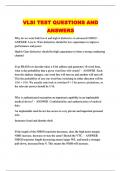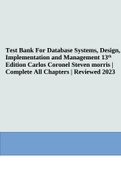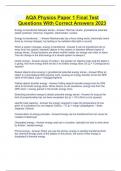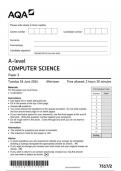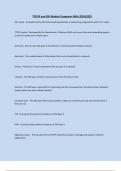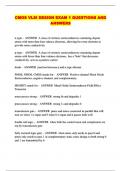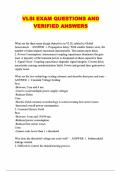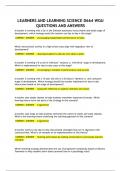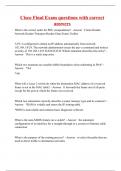Which of the four involuntary vergence stimuli is driven by neural innervation?
Proximal
Accommodative
Fusional Tonic Answer- Tonic vergence is caused by baseline innervation. This type of vergence is generally maintained when all other vergence stimuli are absent. Proximal stimuli are driven by near objects. The response increases as the distance from the object decreases. Accommodative response results from target defocus. Fusional involuntary vergence is provoked by retinal disparity.
Which 3 tests directly examine the accommodative system? (Select 3)
Monocular amps
MEM
Positive fusional convergence ranges
monocular facility testing with +/-2.00D lenses
Stereopsis
Second-degree fusion Answer- Monocular amps, MEM, monocular facility MEM measures the accuracy of the accommodative response to a given target. Monocular amplitudes and monocular facility also evaluate the performance of the accommodative system. PFC measures the interaction between the accommodative and the vergence system. Stereopsis is a product of binocular retinal disparity. Stereopsis is not a measure of accommodation but serves to evaluate the capability of the eyes to work in unison. Although accommodation must be accounted for when performing this test, stereopsis will not quantify any type of accommodative dysfunction. Stereopsis as a cue to depth works best if the objects are not too far away. In order for stereopsis to occur, the retinal disparity must be within a certain limit to result in a perception of depth. Second-degree fusion is the ability to superimpose like objects (not necessarily identical objects), with the end result being the perception of a single object that is a composition of the two separate images. The Worth 4 dot is an example of a test that
evaluates second-degree fusion. Second-degree fusion evaluates if the eyes are capable of working together and does not measure accommodative capability. A 6-year old white male presents with a mild left head turn. Wet retinoscopy reveals OD: +0.25 OS: +0.50 with best corrected acuities of 20/20 in each eye. Extraocular movements show limited adduction of the left eye in right gaze. It is also noted that the left eye retracts with a narrowing of the eyelid fissure. What is the most appropriate diagnosis for this patient?
Duane type 3 OS
Duane type 1 OS
Brown syndrome OS
Bilateral Brown Syndrome Duane type 2 OD
Duane type 2 OS Answer- Duane Syndrome Type III OS In this case, Duane Syndrome is suspected due to the presence of an extraocular muscle deficit and the additional sign of eye retraction and narrowing of the eyelid fissure. Duane Syndrome Type III is the most appropriate diagnosis due to the limited ADDuction of the affected eye on right gaze, along with the left head turn, which also implies limited ABDuction as well. Duane Syndrome Type I describes limited ABDuction of the affected eye (the most common) as well as a possible compensatory head turn toward the involved side. Duane Syndrome Type II describes limited ADDuction of the affected eye, as well as
a possible compensatory head turn toward the uninvolved side. Duane Syndrome Type III describes limited ABDuction AND limited ADDuction of the
affected eye. It also usually presents with a compensatory head turn toward the involved side. A good way to remember the difference between the three types is that type I results
in an aBDuction deficit (aBDuction has one D therefore it is type I). Type II causes an aDDuction deficit (aDDuction has two Ds therefore it is type II). Type III has three Ds, aBDuction and aDDuction-the number of the types matches the number of Ds in the deficit. Brown syndrome describes a limitation of elevation in adduction. It is a limitation of the superior oblique tendon.
When determining the near point of convergence, which of the following sentences is
TRUE?
-As the target is moved closer, diplopia is typically reported prior to blurring of the target -The maximal point of divergence is recorded in centimeters as the 'break point' -As the object is moved closer, the accommodative system maintains the target clarity while the convergence system preserves fusion of the object -If diplopia is not reported by the patient, the test should be repeated until the patient reports blurring of the target Answer- The near point of convergence (NPC) is the point in which the patient's eyes are maximally converged. The NPC is determined by presenting the patient with an appropriate accommodative target at near and with the patient's near correction in place, the patient is asked to keep the target clear and single. The target is then brought closer to the patient until either the patient reports that the image of the object appears double or the clinician notes that one of the patient's eyes turns out. This point is measured and recorded from the spectacle plane in centimeters. While performing the NPC, the convergence system maintains fusion of the target and accommodation sustains clarity. Some patients may report blurring of the target (near point of accommodation) prior to experiencing diplopia, but rarely do patients report blurring of the target after experiencing diplopia. The majority of clinicians record 'TTN' or 'to the nose' for patients who do not report diplopia or do not exhibit a break in fusion.
A patient with a low AC/A ratio (2/1) displays exophoria at a 6 m distance. Based on the AC/A ratio, how would you expect the phoria to change as the target is brought closer to the patient?
-Decrease in exo deviation -The deviation will remain unchanged -Decrease in hyper deviation -Increase in hyper deviation -Increase in exo deviation Answer- Increase in exo deviation The AC/A ratio denotes the amount of change to convergence resulting from a change in accommodation. Regardless of the initial phoria, with decreasing viewing distance the phoria will become more exo (or less eso) for a patient who exhibits a low AC/A ratio. The opposite holds true for a high AC/A ratio (greater than 6/1); as the target gets closer, the resultant phoria becomes more eso or less exo.
A 47-year old man sustained orbital trauma and now presents with complaints of retro-orbital pain, impaired ability to move the eye, a droopy eyelid, and diplopia. These signs are most consistent with damage to which of the following structures?
-Superior orbital fissure
-Internal auditory meatus -Stylomastoid foramen -Superficial temporal artery Answer- Superior orbital fissure
The superior orbital fissure is a cleft between the lesser and greater wings of the sphenoid. Structures traveling through the superior orbital fissure include the oculomotor nerve (CN III), trochlear nerve (CN IV), abducens nerve (CN VI), lacrimal
nerve, frontal nerve, nasociliary nerve, and the ophthalmic vein (superior and inferior divisions). These structures can be damaged when there is orbital trauma causing fractures through the floor of the orbit into the maxillary sinus. This leads to superficial orbital fissure syndrome (also known as Rochon-Duvigneaud's syndrome). Signs include paralysis of extraocular muscles, diplopia, ptosis, exophthalmia and decreased sensation of the upper eyelid and forehead. Vision loss
or blindness implies a more serious injury involving the orbital apex (orbital apex syndrome). Tolusa-Hunt syndrome (THS) is an inflammatory condition within the cavernous sinus or superior orbital fissure causing damage to the structures in those regions. Signs are usually acute and unilateral at onset in adults and the most common presenting signs are pain and ophthalmoparesis. The internal auditory (or acoustic) meatus is a canal in the petrous portion of the temporal bone through which the facial (CN VII) and vestibulocochlear nerves (CN VIII) and the labyrinthine artery travel. Damage to these structures can result in deafness and facial muscle paralysis. Acoustic neuromas will commonly expand the internal auditory meatus and damage these structures. Other signs may include tinnitus or vertigo. The stylomastoid foramen is the termination of the facial canal between the styloid and mastoid processes of the temporal bone. The facial nerve and stylomastoid artery travel through this area. Damage to this area can result in facial drooping and paralysis. Bell's palsy (idiopathic facial nerve paralysis) is an inflammatory condition that may lead to swelling of the facial nerve in this region. The superficial temporal artery is a major artery arising from the bifurcation of the external carotid artery. The artery begins within the parotid salivary gland and passes over the zygomatic process of the temporal bone. It is often affected in cases
of giant cell arteritis (which is also known as temporal arteritis for this reason). This condition is a vasculitis of the medium and large arteries of the head and is not necessarily restricted to the temporal artery. Temporal arteritis is seen predominantly
in older patients and is characterized by fever, headache, sensitivity on the scalp, jaw pain, reduced visual acuity or vision loss, diplopia, and acute tinnitus. Due to potentially rapid progressive vision loss, this disease is a medical emergency. Treatment usually consists of high-dose corticosteroids.
A 22 year-old male presents with a history of a right orbital medial wall fracture and restriction in right gaze on extraocular muscle testing. Which of the following additional tests is MOST useful in determining whether the limitation is secondary to muscle entrapment or muscle paralysis? Forced duction testing Visual evoked potential Cover test Electrooculogram Exophthalmometry X-ray imaging Answer- Forced duction testing Forced duction testing is an in-office procedure that is used in differentiating between
muscle weakness and restrictive causes of limitations in extraocular muscle movements. This test is typically performed when a patient is anesthetized using topical eye drops. The patient is then instructed to look as far as possible in the direction of the muscle that is suspected of underacting such that maximum innervation is recruited to that muscle. The examiner will then use forceps in order to
grasp the conjunctiva as close to the area of the limbus as possible, opposite the side of gaze restriction. If the forceps can then rotate the globe further than where the patient can move it on his own, some degree of muscle paresis is likely. However, if the globe cannot be rotated farther, restriction or entrapment of the muscle is probable. For example, if the patient has a deficit in superior gaze, the insertion of the inferior rectus muscle should be topically anesthetized. The patient's gaze should then be directed upwards and the inferior rectus muscle should be grasped with forceps. Further superior rotation of the eye should then be attempted.

